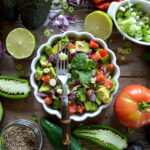Get the Scoop on Nutrition with Emma Stirling
The scoop on nutrition health halos and how they trick us into treats

Emma Stirling APD
In today’s health-aware world we are bombarded with nutrition messages. Words like ‘natural’, ‘diet’, ‘light’, and ‘low- or no-fat’ entice us with ‘ticks’, ‘star bursts’ and other bells and whistles every time we shop or stop for food. But can you accurately assess these supposedly healthier foods on face value? Or could their seemingly saintly glow really turn out to be just a health halo?

What is a nutrition health halo? Dubbed the Sherlock Holmes of food, Director of Cornell University’s Food and Brand Lab, Dr Brian Wansink is credited with coining the phrase ‘health halo’. It’s an effect that occurs when we make the assumption that a particular food is healthy because of a positive association with the parent brand or positive nutrition and health claims. One example is Wansink’s case of Subway versus McDonald’s. Subway carries a health halo due to the perception that its menu contains better choices (all those salad rolls). McDonald’s on the other hand carries the burden of a health shadow after years as the fast food king (all those fries). However, on closer inspection it is clear that McDonald’s now offers many better-for-you options, such as salads. And Subway has its fair share of not-so-heavenly-for-your-health chocolate chip cookies, large sodas and sandwiches high in calories or kilojoules and saturated fat. We can be tricked by a health halo in a number of ways:
Tunnel vision Research into the area has revealed that it’s common for people to misinterpret or latch onto a single nutrient or health claim like ‘low fat’, which may mask the true picture or total nutrient profile of a food. For example, when you take time to look at the nutrition information panel, you may find your favourite low fat ice-cream is high in added refined sugar and consequently has a similar calorie or kilojoule count per serve to another brand without the ‘low fat’ claim.
Under estimates It’s also common for people to dramatically underestimate the calorie or kilojoule content, and eat more of a food, because it comes from a brand perceived to be healthier. A recent study by the University of Michigan revealed that organic claims influenced how ‘fattening” subjects perceived a food to be. Subjects were more likely to underestimate the calories or kilojoules when told a cookie was “organic” compared with a conventional cookie.
False permission Finally, many of us give ourselves the OK to eat a treat food as a reward for choosing a food with a health halo, resulting in a far greater overall calorie or kilojoule intake. A classic example is pairing a diet cola with a doughnut. It is clear that any calories or kilojoules saved by switching from regular to diet cola, does not miraculously cancel out the calorie-loaded treat. This effect can also apply to other aspects of lifestyle behaviour. In the University of Michigan study above, subjects were less critical when someone had an ‘organic’ dessert and skipped exercise.
Devil is in the details The best way to avoid being caught by a health halo is learn the steps to being an avid label reader and favour whole foods close to the natural source like fruits, vegetables, nuts, seeds and wholegrains. Come on over to The Scoop on Nutrition and watch our latest video on the hottest new wholegrains in town that can help boost your nutrient intake and manage your blood glucose levels.
Emma Stirling is an Accredited Practising Dietitian and health writer with over ten years experience writing for major publications. She is editor of The Scoop on Nutrition – a blog by expert dietitians. Check it out or subscribe for hot news bites and a healthy serve of what’s in flavour.







